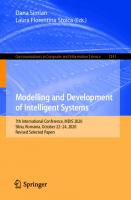Modelling and Development of Intelligent Systems: 6th International Conference, MDIS 2019, Sibiu, Romania, October 3-5, 2019, Revised Selected Papers 3030392368, 9783030392369
This volume constitutes the refereed proceedings of the 6th International Conference on Modelling and Development of Int
283 49 18MB
English Pages 224 [211] Year 2020
Table of contents :
Preface
Organization
Plenary Lecture 1
Intelligent Real-Time Control of Ground Robots
Plenary Lecture 2
Using Primitive Brains to Achieve Emergent Smart Solutions
Plenary Lecture 3
Swarm Intelligence Applied to Medical Image Analysis
Contents
Adaptive Systems
A Model of a Weighted Agent System for Personalised E-Learning Curriculum
1 Introduction
2 Adaptive E-Learning Systems
2.1 Components of an Adaptive E-Learning System
3 Literature Survey
4 Proposed Model
4.1 System Architecture and Component Details
4.2 Adaptation Process
5 Conclusion and Future Work
References
From Digital Learning Resources to Adaptive Learning Objects: An Overview
1 Introduction
2 Adaptive Hypermedia Systems
2.1 Adaptivity in Online Learning Environments
2.2 Adaptive Educational Hypermedia Systems
2.3 Approaches to Adaptive Technologies for AEHS
3 Digital Learning Resources and Learning Objects
3.1 Digital Learning Resources
3.2 Learning Objects
3.3 Standards for Learning Objects
4 Adaptive Learning Objects
4.1 From Learning Objects to Adaptive Learning Objects
4.2 Approaches to Adaptive Learning Objects
5 State-of-the-Art Models for ALOs
6 Conclusion and Future Work
References
Agile-Based Product Line Tool Development
1 Introduction
2 Requirements
3 State of the Art
4 Solutions
4.1 1st Project: Feature Toolset
4.2 2nd Project: Product Line Generator
5 Comparison of Approaches and Conclusion
6 Future Work
References
Conceptual Modelling
Conceptual Model Engineering for Industrial Safety Inspection Based on Spreadsheet Data Analysis
1 Introduction
2 Related Works
3 The Methodology
3.1 Main Steps
3.2 Example
4 Discussion and Conclusions
References
Data Mining
Nonlinearity Estimation of Digital Signals
1 Introduction
2 The State of the Problem
3 Nonlinearity Estimation of Digital Signals
4 MATLAB Realization
5 Experimental Results
6 Conclusions
References
Aggregation on Learning to Rank for Consumer Health Information Retrieval
1 Introduction
2 Related Work
2.1 Learning to Rank in Health Search
2.2 Rank Aggregation Techniques
3 Proposal
3.1 Features Extracted
3.2 Aggregation Strategies
4 Experiments
4.1 Data Collections
4.2 Experimental Setup
4.3 Baselines
4.4 Developed Rankers
5 Results
5.1 Aggregated Rankers Evaluation
5.2 Aggregation Methods Analysis
6 Conclusion and Future Work
References
Intelligent Systems for Decision Support
Intelligent System for Generation and Evaluation of e-Learning Tests Using Integer Programming
1 Introduction
2 Algorithm of Intelligent System for Generating and Evaluating e-Learning Tests
3 Mathematical Model Based on Integer Programming for Generating and Evaluating e-Learning Tests
3.1 Mathematical Model for Selection of Fewer Questions with Higher Degree of Difficulty
3.2 Mathematical Model for Selection of More Questions with Less Degree of Difficulty
4 Numerical Application
5 Result Analysis
5.1 Application of the Mathematical Model for Minimization/Maximization of the Questions’ Number Within the Generated Test
5.2 Application of the Developed Prototype of the Intelligent System for Generation and Evaluation of e-Learning Tests Using 0–1 Integer Programming
6 Conclusions
References
Developed Framework Based on Cognitive Computing to Support Personal Data Protection Under the GDPR
1 Introduction
2 Literature Review
2.1 Personal Data Protection in the IT Context
2.2 What Changes with the GDPR?
2.3 Cognitive Technology and Personal Data Protection
3 Related Work
4 Framework Design and Methodology
4.1 Systematic Review
4.2 Framework: Description and Design
5 Discussion: The Role of Cognitive Computing
6 Conclusion, Limitation and Future Research
References
Machine Learning
Prediction of Greenhouse Series Evolution. A Case Study
1 Introduction
2 Study Region and Data Acquisition
3 Mathematical Modeling
3.1 Data Series Statistical Analysis
3.2 Change Points Detection
3.3 Series Stationarity
3.4 Additive/Multiplicative Seasonal Decomposition
3.5 Series Evolution Forecast
3.6 AR(p)
4 Results
4.1 Statistical Analysis
4.2 Break Points Detection
4.3 KPSS Test
4.4 Seasonal Decomposition
4.5 Smoothing Methods
4.6 AR Model
5 Conclusion
References
Analysing Facial Features Using CNNs and Computer Vision
1 Introduction
2 State of the Art
3 Proposed Solution for a Facial Analysis System
4 Learning-Based Facial Features Detection
4.1 Gender Detection
4.2 Face Detection and Face Landmark Localization
4.3 Hair Segmentation and Hair Geometry Estimation
4.4 Eyeglasses Detection and Shape Estimation
5 Image Processing-Based Facial Features Detection
5.1 Skin Segmentation
5.2 Skin Color Extraction
5.3 Eyebrow Detection
5.4 Iris Localization and Color Recognition
6 Experimental Results
6.1 Train and Test Datasets
7 Conclusions and Future Work
References
Composite SVR Based Modelling of an Industrial Furnace
1 Introduction
2 White, Black and Grey Model Approaches
3 Modelling a Billet Heating Furnace
3.1 The Furnace
3.2 Computational Fluid Dynamics Model
3.3 Reduced-Order Model
3.4 Machine Learning Model
4 Experiments and Results
4.1 Support Vector Regression
4.2 Dataset
4.3 Experiments
4.4 Experimental Setup
4.5 Results
5 Conclusions and Future Work
References
A Conceptual Framework for Software Fault Prediction Using Neural Networks
1 Introduction
2 Setting the Context
2.1 Object Oriented Design Model
2.2 Metrics Used
2.3 Neural Networks
3 Problem Statement
3.1 Formal Statement of SFP Problem
3.2 Objectives and Research Questions
4 Software Fault Prediction – Related Work
5 Proposed Model and Experiments
5.1 Benchmark Dataset
5.2 Data Preprocessing
5.3 Neural Network Prediction Model Description
5.4 Experiments Description
5.5 Results and Validation
6 Conclusions and Future Work
References
Support Vector Machine Optimized by Fireworks Algorithm for Handwritten Digit Recognition
1 Introduction
2 Literature Review
3 Guided Fireworks Algorithm
4 The Proposed Algorithm
4.1 Feature Extraction
4.2 Classification
5 Experimental Results
6 Conclusion
References
Author Index
Preface
Organization
Plenary Lecture 1
Intelligent Real-Time Control of Ground Robots
Plenary Lecture 2
Using Primitive Brains to Achieve Emergent Smart Solutions
Plenary Lecture 3
Swarm Intelligence Applied to Medical Image Analysis
Contents
Adaptive Systems
A Model of a Weighted Agent System for Personalised E-Learning Curriculum
1 Introduction
2 Adaptive E-Learning Systems
2.1 Components of an Adaptive E-Learning System
3 Literature Survey
4 Proposed Model
4.1 System Architecture and Component Details
4.2 Adaptation Process
5 Conclusion and Future Work
References
From Digital Learning Resources to Adaptive Learning Objects: An Overview
1 Introduction
2 Adaptive Hypermedia Systems
2.1 Adaptivity in Online Learning Environments
2.2 Adaptive Educational Hypermedia Systems
2.3 Approaches to Adaptive Technologies for AEHS
3 Digital Learning Resources and Learning Objects
3.1 Digital Learning Resources
3.2 Learning Objects
3.3 Standards for Learning Objects
4 Adaptive Learning Objects
4.1 From Learning Objects to Adaptive Learning Objects
4.2 Approaches to Adaptive Learning Objects
5 State-of-the-Art Models for ALOs
6 Conclusion and Future Work
References
Agile-Based Product Line Tool Development
1 Introduction
2 Requirements
3 State of the Art
4 Solutions
4.1 1st Project: Feature Toolset
4.2 2nd Project: Product Line Generator
5 Comparison of Approaches and Conclusion
6 Future Work
References
Conceptual Modelling
Conceptual Model Engineering for Industrial Safety Inspection Based on Spreadsheet Data Analysis
1 Introduction
2 Related Works
3 The Methodology
3.1 Main Steps
3.2 Example
4 Discussion and Conclusions
References
Data Mining
Nonlinearity Estimation of Digital Signals
1 Introduction
2 The State of the Problem
3 Nonlinearity Estimation of Digital Signals
4 MATLAB Realization
5 Experimental Results
6 Conclusions
References
Aggregation on Learning to Rank for Consumer Health Information Retrieval
1 Introduction
2 Related Work
2.1 Learning to Rank in Health Search
2.2 Rank Aggregation Techniques
3 Proposal
3.1 Features Extracted
3.2 Aggregation Strategies
4 Experiments
4.1 Data Collections
4.2 Experimental Setup
4.3 Baselines
4.4 Developed Rankers
5 Results
5.1 Aggregated Rankers Evaluation
5.2 Aggregation Methods Analysis
6 Conclusion and Future Work
References
Intelligent Systems for Decision Support
Intelligent System for Generation and Evaluation of e-Learning Tests Using Integer Programming
1 Introduction
2 Algorithm of Intelligent System for Generating and Evaluating e-Learning Tests
3 Mathematical Model Based on Integer Programming for Generating and Evaluating e-Learning Tests
3.1 Mathematical Model for Selection of Fewer Questions with Higher Degree of Difficulty
3.2 Mathematical Model for Selection of More Questions with Less Degree of Difficulty
4 Numerical Application
5 Result Analysis
5.1 Application of the Mathematical Model for Minimization/Maximization of the Questions’ Number Within the Generated Test
5.2 Application of the Developed Prototype of the Intelligent System for Generation and Evaluation of e-Learning Tests Using 0–1 Integer Programming
6 Conclusions
References
Developed Framework Based on Cognitive Computing to Support Personal Data Protection Under the GDPR
1 Introduction
2 Literature Review
2.1 Personal Data Protection in the IT Context
2.2 What Changes with the GDPR?
2.3 Cognitive Technology and Personal Data Protection
3 Related Work
4 Framework Design and Methodology
4.1 Systematic Review
4.2 Framework: Description and Design
5 Discussion: The Role of Cognitive Computing
6 Conclusion, Limitation and Future Research
References
Machine Learning
Prediction of Greenhouse Series Evolution. A Case Study
1 Introduction
2 Study Region and Data Acquisition
3 Mathematical Modeling
3.1 Data Series Statistical Analysis
3.2 Change Points Detection
3.3 Series Stationarity
3.4 Additive/Multiplicative Seasonal Decomposition
3.5 Series Evolution Forecast
3.6 AR(p)
4 Results
4.1 Statistical Analysis
4.2 Break Points Detection
4.3 KPSS Test
4.4 Seasonal Decomposition
4.5 Smoothing Methods
4.6 AR Model
5 Conclusion
References
Analysing Facial Features Using CNNs and Computer Vision
1 Introduction
2 State of the Art
3 Proposed Solution for a Facial Analysis System
4 Learning-Based Facial Features Detection
4.1 Gender Detection
4.2 Face Detection and Face Landmark Localization
4.3 Hair Segmentation and Hair Geometry Estimation
4.4 Eyeglasses Detection and Shape Estimation
5 Image Processing-Based Facial Features Detection
5.1 Skin Segmentation
5.2 Skin Color Extraction
5.3 Eyebrow Detection
5.4 Iris Localization and Color Recognition
6 Experimental Results
6.1 Train and Test Datasets
7 Conclusions and Future Work
References
Composite SVR Based Modelling of an Industrial Furnace
1 Introduction
2 White, Black and Grey Model Approaches
3 Modelling a Billet Heating Furnace
3.1 The Furnace
3.2 Computational Fluid Dynamics Model
3.3 Reduced-Order Model
3.4 Machine Learning Model
4 Experiments and Results
4.1 Support Vector Regression
4.2 Dataset
4.3 Experiments
4.4 Experimental Setup
4.5 Results
5 Conclusions and Future Work
References
A Conceptual Framework for Software Fault Prediction Using Neural Networks
1 Introduction
2 Setting the Context
2.1 Object Oriented Design Model
2.2 Metrics Used
2.3 Neural Networks
3 Problem Statement
3.1 Formal Statement of SFP Problem
3.2 Objectives and Research Questions
4 Software Fault Prediction – Related Work
5 Proposed Model and Experiments
5.1 Benchmark Dataset
5.2 Data Preprocessing
5.3 Neural Network Prediction Model Description
5.4 Experiments Description
5.5 Results and Validation
6 Conclusions and Future Work
References
Support Vector Machine Optimized by Fireworks Algorithm for Handwritten Digit Recognition
1 Introduction
2 Literature Review
3 Guided Fireworks Algorithm
4 The Proposed Algorithm
4.1 Feature Extraction
4.2 Classification
5 Experimental Results
6 Conclusion
References
Author Index

- Author / Uploaded
- Dana Simian
- Laura Florentina Stoica
- Similar Topics
- Computers
- Cybernetics: Artificial Intelligence








![Data Analytics and Management in Data Intensive Domains: 21st International Conference, DAMDID/RCDL 2019, Kazan, Russia, October 15–18, 2019, Revised Selected Papers [1st ed.]
9783030519124, 9783030519131](https://ebin.pub/img/200x200/data-analytics-and-management-in-data-intensive-domains-21st-international-conference-damdid-rcdl-2019-kazan-russia-october-1518-2019-revised-selected-papers-1st-ed-9783030519124-9783030519131.jpg)
